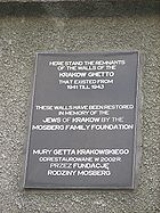
Kraków Ghetto
Encyclopedia
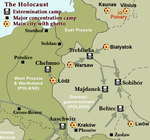
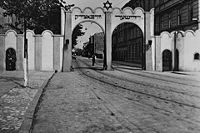


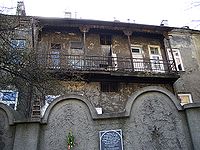
Nazi Germany
Nazi Germany , also known as the Third Reich , but officially called German Reich from 1933 to 1943 and Greater German Reich from 26 June 1943 onward, is the name commonly used to refer to the state of Germany from 1933 to 1945, when it was a totalitarian dictatorship ruled by...
in the General Government
General Government
The General Government was an area of Second Republic of Poland under Nazi German rule during World War II; designated as a separate region of the Third Reich between 1939–1945...
(Generalgouvernement) territory for the purpose of persecution, terror, and exploitation of Polish Jews during the German occupation of Poland
Poland
Poland , officially the Republic of Poland , is a country in Central Europe bordered by Germany to the west; the Czech Republic and Slovakia to the south; Ukraine, Belarus and Lithuania to the east; and the Baltic Sea and Kaliningrad Oblast, a Russian exclave, to the north...
in World War II
World War II
World War II, or the Second World War , was a global conflict lasting from 1939 to 1945, involving most of the world's nations—including all of the great powers—eventually forming two opposing military alliances: the Allies and the Axis...
. It was a staging point to begin dividing "able workers" from those who would later be deemed unworthy of life. The Ghetto was liquidated between June 1942 and March 1943, with most of its inhabitants sent to Belzec
Belzec
Bełżec is a village in Tomaszów Lubelski County, Lublin Voivodeship, in eastern Poland. It is the seat of the gmina called Gmina Bełżec. It lies approximately south of Tomaszów Lubelski and south-east of the regional capital Lublin.During World War II it was the site of the Nazi Bełżec...
and Płaszów, and exterminated at Auschwitz concentration camp
Auschwitz concentration camp
Concentration camp Auschwitz was a network of Nazi concentration and extermination camps built and operated by the Third Reich in Polish areas annexed by Nazi Germany during World War II...
.
History
Before the German attack on Poland, KrakówKraków
Kraków also Krakow, or Cracow , is the second largest and one of the oldest cities in Poland. Situated on the Vistula River in the Lesser Poland region, the city dates back to the 7th century. Kraków has traditionally been one of the leading centres of Polish academic, cultural, and artistic life...
(Cracow) was an influential cultural centre for the Polish Jews who lived there since the 13th century. Persecution of the Jewish population of Kraków began soon after the German troops entered the city on September 1, 1939, in the course of their invasion of Poland. Jews were obliged to take part in forced labor from September on. In November 1939, all Jews 12 years or older were required to wear identifying armband
Armband
An armband is a piece of material worn around the arm over the sleeve of other clothing if present. they may be worn for pure ornamentation to mark the wearer as belonging to group, having a certain rank or role, or being in a particular state or condition...
s. Throughout Kraków, synagogues were ordered closed and all their relics and valuables turned over to the Nazi authorities.
By May 1940, the Nazi
Nazi Germany
Nazi Germany , also known as the Third Reich , but officially called German Reich from 1933 to 1943 and Greater German Reich from 26 June 1943 onward, is the name commonly used to refer to the state of Germany from 1933 to 1945, when it was a totalitarian dictatorship ruled by...
occupation authority announced that Kraków should become the "cleanest" city in the General Government
General Government
The General Government was an area of Second Republic of Poland under Nazi German rule during World War II; designated as a separate region of the Third Reich between 1939–1945...
(an occupied, but unannexed part
Polish areas annexed by Nazi Germany
At the beginning of World War II, nearly a quarter of the pre-war Polish areas were annexed by Nazi Germany and placed directly under German civil administration, while the rest of Nazi occupied Poland was named as General Government...
of Poland). Massive deportation of Jews from the city were ordered. Of the more than 68,000 Jews in Kraków when the Germans invaded, only 15,000 workers and their families were permitted to remain. All other Jews were ordered out of the city, to be resettled into surrounding rural areas.
The Kraków Ghetto was formally established on March 3, 1941 in the Podgórze
Podgórze
Podgórze is a district of Kraków, Poland, situated on the right bank of the Vistula River. Initially a village at the foot of Lasota Hill was granted city status by the Austrian Emperor Joseph II in 1784 and has become Royal Free City of Podgorze...
district, not in the Jewish district of Kazimierz
Kazimierz
Kazimierz is a historical district of Kraków , best known for being home to a Jewish community from the 14th century until the Second World War.-Early history:...
. Displaced Polish families from Podgórze took up residences in the former Jewish dwellings outside the newly established Ghetto. Meanwhile, 15,000 Jews were crammed into an area previously inhabited by 3,000 people who used to live in a district consisting of 30 streets, 320 residential buildings, and 3,167 rooms. As a result, one apartment was allocated to every four Jewish families, and many less fortunate lived on the street.
The Ghetto was surrounded by walls that kept it separated from the rest of the city. All windows and doors that gave onto the "Aryan
Aryan
Aryan is an English language loanword derived from Sanskrit ārya and denoting variously*In scholarly usage:**Indo-Iranian languages *in dated usage:**the Indo-European languages more generally and their speakers...
" side were ordered bricked up. Only four guarded entrances allowed traffic to pass through. In a grim foreshadowing of the near future, these walls contained panels in the shape of tombstones. Small sections of the wall still remain today.
Young people of the Akiva youth movement
Zionist youth movement
A Zionist youth movement is an organization formed for Jewish children and adolescents for educational, social, and ideological development, including a belief in Jewish nationalism as represented in the State of Israel...
, who had undertaken the publication of an underground newsletter, HeHaluc HaLohem ("The Fighting Pioneer"), joined forces with other Zionists to form a local branch of the Jewish Fighting Organization (ŻOB, Polish
Polish language
Polish is a language of the Lechitic subgroup of West Slavic languages, used throughout Poland and by Polish minorities in other countries...
: Żydowska Organizacja Bojowa), and organize resistance in the ghetto, supported by the Polish underground Armia Krajowa
Armia Krajowa
The Armia Krajowa , or Home Army, was the dominant Polish resistance movement in World War II German-occupied Poland. It was formed in February 1942 from the Związek Walki Zbrojnej . Over the next two years, it absorbed most other Polish underground forces...
. The group carried out a variety of resistance activities including the bombing of the Cyganeria cafe, a gathering place of Nazi officers. Unlike in Warsaw
Warsaw Ghetto
The Warsaw Ghetto was the largest of all Jewish Ghettos in Nazi-occupied Europe during World War II. It was established in the Polish capital between October and November 15, 1940, in the territory of General Government of the German-occupied Poland, with over 400,000 Jews from the vicinity...
, their efforts did not lead to a general uprising
Warsaw Ghetto Uprising
The Warsaw Ghetto Uprising was the Jewish resistance that arose within the Warsaw Ghetto in German occupied Poland during World War II, and which opposed Nazi Germany's effort to transport the remaining ghetto population to Treblinka extermination camp....
before the ghetto was liquidated.
From May 30, 1942 onward, the Nazis implemented systematic deportations from the Ghetto to surrounding concentration camps. Thousands of Jews were transported in the succeeding months as part of the Aktion Krakau
Aktion Krakau
Operation Reinhard in Kraków was a major 1942 German Nazi anti-Jewish operation in Kraków, Poland, headed by SS-Oberführer Julian Scherner as part of the countrywide Aktion Reinhard , mass murder of Polish Jews in General Government under the command of SS and Polizeifuhrer Odilo...
headed by SS-Oberführer
Oberführer
Oberführer was an early paramilitary rank of the Nazi Party dating back to 1921. Translated as “Senior Leader”, an Oberführer was typically a Nazi Party member in charge of a group of paramilitary units in a particular geographical region...
Julian Scherner
Julian Scherner
Julian Scherner was a Nazi Party official who served in the SS as an SS-Oberführer...
. Jews were assembled on Zgody Square first and then escorted to the railway station in Prokocim. The first transport consisted of 7,000 people, the second, of additional 4,000 Jews deported to Bełżec extermination camp on 5 June 1942. On March 13-March 14, 1943 the final 'liquidation' of the ghetto was carried out under the command of SS-Untersturmführer
Untersturmführer
Untersturmführer was a paramilitary rank of the German Schutzstaffel first created in July 1934. The rank can trace its origins to the older SA rank of Sturmführer which had existed since the founding of the SA in 1921...
Amon Göth
Amon Göth
Amon Leopold Göth was an Austrian Nazi and the commandant of the Nazi concentration camp at Płaszów, General Government...
. Eight thousand Jews deemed able to work were transported to the Plaszow labor camp. Those deemed unfit for work – some 2,000 Jews – were killed in the streets of the ghetto on those days. Any remaining were sent to Auschwitz
Auschwitz concentration camp
Concentration camp Auschwitz was a network of Nazi concentration and extermination camps built and operated by the Third Reich in Polish areas annexed by Nazi Germany during World War II...
.
Notable people
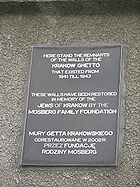
Roman Polanski
Roman Polanski is a French-Polish film director, producer, writer and actor. Having made films in Poland, Britain, France and the USA, he is considered one of the few "truly international filmmakers."...
, a survivor of the Ghetto, evoked his childhood experiences in his memoir, Roman. Polański recalls the early months resembled normalcy; although the peacefulness was sometimes punctuated by fear. Town residents dined out, listened to town bands, and children, such as Polański, socialized in the snow.
Roma Ligocka
Roma Ligocka
Roma Ligocka is a Polish costume designer, writer, and painter.She was born in a Jewish family in Kraków a few years before World War II. During the German occupation of Poland her family was persecuted by the Nazis - her father was incarcerated, first in the Płaszów and then Auschwitz...
, Polish artist and author, and a first cousin to Roman Polański who, as a small girl, was rescued and survived the Ghetto, many years later wrote a novel based on her experiences, The Girl in the Red Coat
The Girl in the Red Coat
The Girl in the Red Coat is a memoir by Polish writer Roma Ligocka , published in November 2003 by Random House....
: A Memoir. She is mistakenly thought to be portrayed in the film Schindler's List
Schindler's List
Schindler's List is a 1993 American film about Oskar Schindler, a German businessman who saved the lives of more than a thousand mostly Polish-Jewish refugees during the Holocaust by employing them in his factories. The film was directed by Steven Spielberg, and based on the novel Schindler's Ark...
. The scene, however, was constructed on the memories of Zelig Burkhut, survivor of Plaszow (and other work camps). When being interviewed by Spielberg before the making for the film, Burkhut told of a young girl wearing a pink coat, no older than four, who was shot by a Nazi officer right before his eyes.
The only working pharmacy enclosed within the Kraków Ghetto belonged to Tadeusz Pankiewicz
Tadeusz Pankiewicz
Tadeusz Pankiewicz , was a Polish Roman Catholic pharmacist, operating in the Kraków Ghetto during the Nazi German occupation of Poland...
, a Polish pharmacist permitted by the German authorities to operate his "Under the Eagle Pharmacy" there upon his request. In recognition of his heroic deeds in rescuing Jews from the Ghetto he was awarded the title of Righteous Among the Nations
Righteous Among the Nations
Righteous among the Nations of the world's nations"), also translated as Righteous Gentiles is an honorific used by the State of Israel to describe non-Jews who risked their lives during the Holocaust to save Jews from extermination by the Nazis....
by Yad Vashem
Yad Vashem
Yad Vashem is Israel's official memorial to the Jewish victims of the Holocaust, established in 1953 through the Yad Vashem Law passed by the Knesset, Israel's parliament....
. Pankiewicz published a book about his time in the ghetto called The Cracow Ghetto Pharmacy (ISBN 0896041158).
Oskar Schindler
Oskar Schindler
Oskar Schindler was an ethnic German industrialist born in Moravia. He is credited with saving over 1,100 Jews during the Holocaust by employing them in his enamelware and ammunitions factories, which were located in what is now Poland and the Czech Republic respectively.He is the subject of the...
, a German businessman, came to Kraków
Kraków
Kraków also Krakow, or Cracow , is the second largest and one of the oldest cities in Poland. Situated on the Vistula River in the Lesser Poland region, the city dates back to the 7th century. Kraków has traditionally been one of the leading centres of Polish academic, cultural, and artistic life...
because of the labor available from the Ghetto. He selected employees to work in his enamelware
Vitreous enamel
Vitreous enamel, also porcelain enamel in U.S. English, is a material made by fusing powdered glass to a substrate by firing, usually between 750 and 850 °C...
plant, and came to view them sympathetically. In 1942, Schindler watched Ghetto inhabitants brutally rounded up for transportation to Płaszów, and subsequently worked furiously to save Jews interned there, events portrayed in the Steven Spielberg
Steven Spielberg
Steven Allan Spielberg KBE is an American film director, screenwriter, producer, video game designer, and studio entrepreneur. In a career of more than four decades, Spielberg's films have covered many themes and genres. Spielberg's early science-fiction and adventure films were seen as an...
film Schindler's List. In an especially dramatic event, 300 of Schindler's workers were deported to the Auschwitz death camp despite his efforts, and he personally intervened to save them.
Mordechai Gebirtig
Mordechai Gebirtig
Mordechai Gebirtig, born Mordecai Bertig was an influential Yiddish poet and songwriter.- S'brent :One of Gebirtig's best-known songs is "S'brent" , written in 1938 in response to the 1936 pogrom of Jews in the shtetl of Przytyk. Gebirtig had hoped its message, “Don't stand there, brothers, douse...
was one of the most influential and popular writers of Yiddish songs and poems. He died there in 1942.
Miriam Akavia
Miriam Akavia
Miriam Akavia is an Israeli writer and translator, she survived the Holocaust, she is a president of Platform for Jewish-Polish Dialogue.- Biography :She was born on 1927 in Krakow in Weinfelds family...
, an Israeli writer, survived the Kraków ghetto and concentration camps. Renowned dermatologist and co-discoverer of Reyes Syndrome, Dr Jim (Jacob) Baral was also a Krakow Ghetto survivor.

